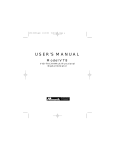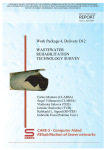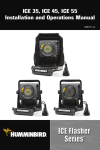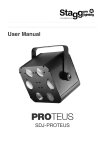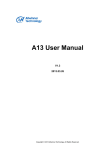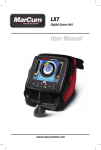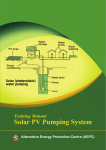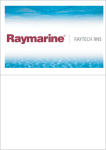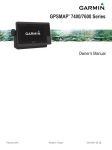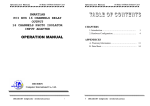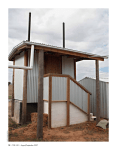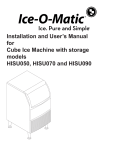Download Depth Manual - Busse Yachtshop
Transcript
A L W A Y S A T T H E F O R E F R O N T O F T E C H N O L O G Y Instruction Manual M A N U A L Simrad IS12 Depth Instrument III IS12 Depth Sounder © 2002 Simrad Ltd The technical data, information and illustrations contained in this publication were to the best of our knowledge correct at the time of going to print. We reserve the right to change specifications, equipment, installation and maintenance instructions without notice as part of our policy of continuous development and improvement. No part of this publication may be reproduced, stored in a retrieval system or transmitted in any form, electronic or otherwise without prior permission from Simrad Ltd. No liability can be accepted for any inaccuracies or omissions in the publication, although every care has been taken to make it as complete and accurate as possible. IV E04050 Issue 1.1 11/01/02 MDL Instruction Manual CONTENTS 1 GENERAL 1.1 Introduction . . . . . . . . . . . . . . . . . . . . . . . . . . . . . . . . . . . . . . . 6 1.2 IS12 Network System . . . . . . . . . . . . . . . . . . . . . . . . . . . . . . . . 7 2 OPERATION 2.1 Water Depth . . . . . . . . . . . . . . . . . . . . . . . . . . . . . . . . . . . . . . . 8 2.2 Alarms . . . . . . . . . . . . . . . . . . . . . . . . . . . . . . . . . . . . . . . . . . . . 9 2.2.1 Shallow Alarm . . . . . . . . . . . . . . . . . . . . . . . . . . . . . . . 9 2.2.2 Deep Alarm . . . . . . . . . . . . . . . . . . . . . . . . . . . . . . . . . 10 2.3 Info Key . . . . . . . . . . . . . . . . . . . . . . . . . . . . . . . . . . . . . . . . . . . 11 2.4 Backlighting . . . . . . . . . . . . . . . . . . . . . . . . . . . . . . . . . . . . . . . 12 2.5 Remote Control / Alarm Option . . . . . . . . . . . . . . . . . . . . . . . 13 3 CALIBRATION 3.1 Selecting Units . . . . . . . . . . . . . . . . . . . . . . . . . . . . . . . . . . . . . 15 3.2 Damping . . . . . . . . . . . . . . . . . . . . . . . . . . . . . . . . . . . . . . . . . . 16 3.3 Offset . . . . . . . . . . . . . . . . . . . . . . . . . . . . . . . . . . . . . . . . . . . . . 17 3.3.1 Keel Offset . . . . . . . . . . . . . . . . . . . . . . . . . . . . . . . . . . 18 3.3.2 Waterline Offset . . . . . . . . . . . . . . . . . . . . . . . . . . . . . . 19 3.4 Switching Transducer Off / On . . . . . . . . . . . . . . . . . . . . . . . . 19 3.5 Local & Network Backlighting . . . . . . . . . . . . . . . . . . . . . . . . 20 3.6 Shop Mode . . . . . . . . . . . . . . . . . . . . . . . . . . . . . . . . . . . . . . . . 21 3.7 Disable Remote Control . . . . . . . . . . . . . . . . . . . . . . . . . . . . . . 21 4 INSTALLATION 4.1 Instrument Head Installation . . . . . . . . . . . . . . . . . . . . . . . . . . 22 4.1.1 Front Mounting . . . . . . . . . . . . . . . . . . . . . . . . . . . . . . 22 4.1.2 Rear Mounting . . . . . . . . . . . . . . . . . . . . . . . . . . . . . . . 24 4.2 Transducer Installation . . . . . . . . . . . . . . . . . . . . . . . . . . . . . . . 25 4.2.1 Selecting a Suitable Location . . . . . . . . . . . . . . . . . . . . 25 4.2.2 Cutting and Sealing the Hole . . . . . . . . . . . . . . . . . . . 26 4.2.3 Installing the Transducer . . . . . . . . . . . . . . . . . . . . . . . 27 4.3 Electrical Installation . . . . . . . . . . . . . . . . . . . . . . . . . . . . . . . . 28 4.4 Electronic Interference Suppression . . . . . . . . . . . . . . . . . . . . 29 5 APPENDIX 5.1 5.2 5.3 5.4 5.5 5.6 Notes on Turbulence & Signal Acquisition . . . . . . . . . . . . . . 30 Fault Finding . . . . . . . . . . . . . . . . . . . . . . . . . . . . . . . . . . . . . . . 31 Spares and Accessories . . . . . . . . . . . . . . . . . . . . . . . . . . . . . . . 31 Dimensions . . . . . . . . . . . . . . . . . . . . . . . . . . . . . . . . . . . . . . . . 32 Specification . . . . . . . . . . . . . . . . . . . . . . . . . . . . . . . . . . . . . . . 32 Service & Warranty . . . . . . . . . . . . . . . . . . . . . . . . . . . . . . . . . . 32 V IS12 Depth Sounder 1 GENERAL 1.1 Introduction The Simrad IS12 System is a flexible modular series of instruments that offer large, clear displays, easy to operate functions and robust, weatherproof construction. Whether as a stand alone instrument, or as part of a networked navigation system, the IS12 Depth Sounder will offer superb performance. DEPTH DEPTH M LIGHT SHALL DEEP INFO Fig 1.1 - IS12 Depth Sounder Instrument The IS12 Depth Sounder system is supplied complete with a through hull depth transducer and all the necessary cabling. All functions are easily accessed, thanks to IS12’s intuitive, user friendly control system. Thank you for choosing Simrad. If you are pleased with your instrument we hope you will be interested in our range of marine electronic equipment, which is manufactured to the same high standards as IS12. Please contact your nearest Simrad agent for a catalogue showing our increasing range of high tech navigational instruments, GPS, Autopilots, Radar, Fishfinders and VHF radio sets. Simrad operate a policy of continual development and reserve the right to alter and improve the specification of their products without notice. 6 E04050 Instruction Manual 1.2 IS12 Network System The IS12 system is built around a high speed bus networking system that allows instruments to be easily interconnected and share data. All units are interconnected and powered using a standard single cable (Fig 1.2) - COMPASS Tx WIND Tx MEGA DATA WIND SPEED/LOG DEPTH COMPASS CONTROLLER ALARM Fig 1.2 - IS12 Network System Additional instruments can be added to the system to act as repeaters, for example at the chart table of a sailboat or the flybridge of a powerboat. Thus, as shown in the example above, the Mega and Data Repeater instruments repeat the information from the main instruments. E04050 7 IS12 Depth Sounder 2 OPERATION 2.1 Water Depth On power up, the current water depth is shown (Fig 2.1) - DEPTH DEPTH M LIGHT SHALL DEEP INFO Fig 2.1 - Default Depth Display In this example, the depth is displayed in Metres. The arrow in the top line of the display indicates the trend (up or down). NOTE Refer to section 5.1 in the appendix for further information on how the depth sounder will behave if the depth signal is lost. As a default, the Depth Sounder will display the depth below the transducer. An offset can be entered so that the display shows either the depth below the keel or the waterline depth. Refer to Section 3.3 for more details. 2.2 Alarms The IS12 Depth Sounder features an audible alarm function that can be set to alert if the water depth falls below or above a specified value. This is a useful function to avoid the boat running aground in shallow water, or straying into deep water. NOTE The alarms will sound for 15 seconds when triggered by the alarm condition (unless manually muted), then sound again after a 15 second pause and continue in this pattern until the water depth is once again within the specified parameters. 2.2.1 Shallow Alarm The shallow alarm will sound if the water depth falls below a specified amount, to warn if the boat is about to run aground. 8 E04050 Instruction Manual Press the SHALL key to access the shallow alarm (Fig 2.2) - M LIGHT SHALL DEEP INFO DEPTH SHALL M LIGHT SHALL DEEP INFO Fig 2.2 - Shallow Alarm Function If the shallow alarm is OFF, pressing the or (SHALL or DEEP) keys will switch on the alarm at the previously entered value (Min 0.6m/2ft, Max 100m/327ft). Use the or to adjust the shallow alarm setting in 0.1m or 1ft increments and press (INFO) to confirm and exit to the main screen. Press and hold the 10ft increments. Press or keys to scroll up and down in 1m / (LIGHT) to turn the shallow alarm off. NOTE While the alarm is on, the icon will be shown on the display. NOTE If no key is pressed within 5 seconds, the display will exit to the main screen and any changes will be ignored. If the alarm sounds, press SHALL to mute. E04050 9 IS12 Depth Sounder 2.2.2 Deep Alarm The deep alarm will sound if the water depth goes above a specified amount. Press the DEEP key to access the deep alarm (Fig 2.3) - M LIGHT SHALL DEEP INFO DEPTH DEEP M LIGHT SHALL DEEP INFO Fig 2.3 - Deep Alarm Function If the deep alarm is OFF, pressing the or (SHALL or DEEP) keys will switch on the alarm at the previously entered value (Min 0.6m/2ft, Max 100m/327ft). Use the or keys to adjust the deep alarm setting in 0.1m or 1ft increments and press (INFO) to confirm and exit to the main screen. Press and hold the / 10ft increments. Press NOTE 10 and keys to scroll up and down in 1m (LIGHT) to turn the deep alarm off. While the alarm is on, the icon will be shown on the display. E04050 Instruction Manual NOTE If no key is pressed within 5 seconds, the display will exit to the main screen and any changes will be ignored. If the alarm sounds, press DEEP to acknowledge and cancel. NOTE The deep alarm cannot be set lower than the shallow alarm, and the shallow alarm cannot be set higher than then deep alarm. 2.3 Info Key Pressing the INFO key will cycle through the information that can be shown on the top line of the display (Fig 2.4) - Default (DEPTH) - Shallow alarm setting - Deep alarm setting M LIGHT SHALL DEEP INFO DEPTH SH 1.5 DEPTH DP 45.0 Fig 2.4 - Info Key Functions The selected information will be displayed permanently on the top line until the INFO key is pressed again. E04050 11 IS12 Depth Sounder 2.4 Backlighting The backlighting illuminates the display and the keys, with five levels of brightness. To switch the backlighting on, press the LIGHT key. The display will illuminate and the large digits will show the current lighting level (Fig 2.5) - LIGHT SHALL DEEP INFO DEPTH LIGHT LIGHT SHALL DEEP INFO Fig 2.5 - Turning Backlighting On Four icons will be shown on the bottom line of the display, corresponding to the four keys ( , , and ) Press the (DEEP) key to increase the brightness (max 5), (SHALL) to decrease it (min 1), (INFO) to accept the selected brightness or (LIGHT) to turn the backlighting off. The currently selected lighting level will be applied if no key is pressed after five seconds. NOTE While the backlighting is on, the lamp icon ( on the bottom left of the display. ) will be shown The backlighting can either be Local or Network controlled - see Section 3.5 for more details. 12 E04050 Instruction Manual 2.5 Remote Control / Alarm Option The optional remote control allows all functions of each instrument to be remotely controlled. Any alarms sounded are also repeated on this unit. See Section 3.7 regarding enabling and disabling remote control functionality for this instrument. As this unit is intended to control all instruments in the IS12 range, the keypad is a generic design. Fig 2.6 indicates the respective key positions - DEPTH DEPTH M LIGHT SHALL DEEP INFO Select Instrument Fig 2.6 - Remote Control Key Positions E04050 13 IS12 Depth Sounder 3 CALIBRATION To protect the calibration functions, these are held in a hidden menu. To enter calibration mode, press and hold the LIGHT key (Fig 3.1) - LIGHT SHALL DEEP INFO DEPTH UNITS LIGHT SHALL DEEP INFO Fig 3.1 - Entering Calibration Mode In calibration mode, pressing the (SHALL) or (DEEP) keys will cycle through the available calibration options - Units (Section 3.1) - Damping (Section 3.2) - Offset (Section 3.3) - Transducer Off/On (Section 3.4) - Local / Network Backlighting (Section 3.5) - Shop Mode (Section 3.6) - Disabling Remote Control Facility (Section 3.7) Select the required option and press to enter. While in the calibration options, the following key functions apply - To save settings and return to Cal menu press - To ignore changes and return to Cal menu press . . - To exit calibration mode at any time, press and hold 14 . E04050 Instruction Manual 3.1 Selecting Units Enter calibration mode - the display will show UNITS CAL. Press (INFO). The depth units can then be selected (Metres or Feet) by pressing the or keys (Fig 3.2) - M LIGHT SHALL or DEEP INFO SHALL INFO FT LIGHT DEEP Fig 3.2 - Selecting Depth Units Press NOTE E04050 to set the selected depth units. Press to exit to the main calibration menu without changes being saved. 15 IS12 Depth Sounder 3.2 Damping The Damping function adjusts the update rate of the display. A damping level of 0 (minimum) will cause the display to update rapidly, while a damping level of 4 (maximum) will result in a more stable display, but one that is less frequently updated. Enter calibration mode, press once (the display will show DAMP CAL) and press (INFO). The damping level can be adjusted using the (Fig 3.3) - and keys DEPTH DAMP LIGHT SHALL DEEP INFO Fig 3.3 - Adjusting Damping Level To set the selected damping level, press . The display will then return to the main calibration menu. NOTE 16 Press to exit to the main calibration menu at any point. E04050 Instruction Manual 3.3 Offset As a default, the Depth Sounder displays the water depth between the transducer and the sea bed. However, for boats such as sailing yachts with a keel, it is more useful for the display to show the available water below the keel, which is sometimes as much as 2m below the transducer. In other circumstances it may be more important to show the waterline depth, that is the total depth of water from the bottom to the surface. The IS12 Depth Sounder allows a keel or waterline offset to be entered, so that the displayed depth will more accurately reflect the depth of water available beneath the boat. Waterline Depth transducer Depth below keel Depth below Keel Offset Waterline Offset To calculate the offset amount, measure the vertical distance between the bottom of the keel and the bottom of the transducer for a keel offset, or the vertical distance between the surface of the water and the bottom of the transducer for a waterline offset (Fig 3.4) - Fig 3.4 - Depth Offset NOTE The offset amount will be in the same units as selected in Section 3.1. - ctd E04050 17 IS12 Depth Sounder To enter the offset, enter calibration mode then press (the display will show OFFST CAL) and press . twice The current offset will be displayed - default value 0.0 (Fig 3.5) - DEPTH OFFST M LIGHT SHALL DEEP INFO Fig 3.5 - Entering Offset 3.3.1 Keel Offset Since entering a keel offset is reducing the displayed depth, this is entered using the key - which will adjust the offset in 0.1m /0.1ft decrements. The display will show “KEEL” (Fig 3.6) KEEL M LIGHT SHALL DEEP INFO Fig 3.6 - Entering Keel Offset To set the selected keel offset, press . The display will then return to the main calibration menu. NOTE 18 Press to exit to the main calibration menu at any point. E04050 Instruction Manual 3.3.2 Waterline Offset A waterline offset increases the displayed depth, so this is entered using the key - this adjusts the offset in 0.1m /0.1ft increments. The display will show “W’LN” (Fig 3.7) - W’LN M LIGHT SHALL DEEP INFO Fig 3.7 - Entering Waterline Offset To set the selected waterline offset, press . The display will then return to the main calibration menu. Press NOTE to exit to the main calibration menu at any point. 3.4 Switching Transducer Off / On If the boat is also fitted with a fishfinder running at a similar frequency, there may be some interference between the two transducers. In this case, the transducer can be switched off. This is also useful to conserve power when on a long ocean crossing, where the depth sounder is not needed. DEPTH TRANS LIGHT SHALL DEEP INFO Enter calibration mode, press TRANS CAL) and press . x3 (the display will show The display will show “On”. To turn the transducer off, press the or key (the display will show “OFF”) and press to confirm (Fig 3.8). The display will then return to the main calibration menu. LIGHT SHALL DEEP INFO Fig 3.8 - Switching Transducer Off NOTE E04050 While the transducer is set to off, the main depth display will show OFF. To turn the transducer back on again repeat the above procedure. Press to exit to the main calibration menu at any point. 19 IS12 Depth Sounder 3.5 Local & Network Backlighting The backlighting can be set so that any changes made are duplicated across the system (Network), or so that any changes are limited to this specific instrument only (Local). NOTE The IS12 instruments are set to Networked lighting as default. Enter calibration mode, press four times (the display will show LIGHT on the top line) and press (INFO). The large digits will show the current setting - NET for Networked or LOC for Local. The setting can be changed using the or keys (Fig 3.9) - LIGHT LIGHT SHALL DEEP INFO Fig 3.9 - Changing from Network to Local Backlighting To set the selected backlighting, press return to the main calibration menu. . The display will then NOTE Press NOTE Any changes will affect this specific instrument only. 20 to exit to the main calibration menu at any point. E04050 Instruction Manual 3.6 Shop Mode This is a simulation mode for in-store demonstration - do not use. 3.7 Disable Remote Control On some installations which includes the IS12 Remote Control, it may be more convenient to limit remote control access to only some instruments on the network - for example on a flybridge power boat with a set of instruments on both steering stations, it would not be desirable to be able to control the instruments on the flybridge (Fig 3.10) Flybridge Front mounted instruments - no remote control required Remote control disabled Main Steering Station Rear mounted instruments - remote control required. Remote control enabled Fig 3.10 - Flybridge system with Remote control of main steering system only To disable remote control functionality on this instrument, enter calibration mode, press six times (the display will show CTRL CAL on the top line) and press (INFO). The large digits will show the current setting - ON for remote control enabled or OFF for remote control disabled. The setting can be changed using the or keys. To set the selected mode, press to the main calibration menu. . The display will then return NOTE Press to exit to the main calibration menu at any point. NOTE Any changes will affect this specific instrument only. For further information on Remote Control operation, please refer to the user manual supplied with the Remote Control / Alarm unit. E04050 21 IS12 Depth Sounder 4 INSTALLATION 4.1 Instrument Head Installation All IS12 instrument heads are a standard 110 x 110mm (4.3 x 4.3 in) size, and can be mounted either from the front or the rear. 4.1.1 Front Mounting Fig 4.1 - Front Mounting 35mm (1.4 in) minimum Front mounting (Fig 4.1) is the standard method of fitting and is the most straightforward. When mounting the instrument head it is important to ensure that there is adequate clearance behind the bulkhead for the rear of the instrument with the cables inserted - allow at least 35mm (1.4 in) clearance (Fig 4.2). Additionally, the instrument should not be fitted to a surface that has a curve greater than 1mm (1⁄25 in) across the mounting area. If fixing to an uneven surface, care should be taken not to overtighten the screws. When choosing a location, consideration should be given to the water integrity of the gasket seal if the surface is not flat. IS12 is designed to be weatherproof, but the rear of the instrument case with its electrical connections should be protected from moisture as far as possible. Tools required for installation - Fig 4.2 - Clearance Required Behind Bulkhead -Drill - 86mm (3.4in) hole saw - 2.5mm (0.09in) drill bit - Countersinking bit Using the self adhesive template supplied, drill the central aperture for the instrument case using the hole saw, then the four fixing holes as indicated on the template. If the instruments are to be fixed to a GRP bulkhead, the fixing holes should be countersunk after drilling, to stop the screws splitting the gelcoat. ctd - 22 E04050 Instruction Manual The instrument is 110mm (4.33 in) square, but a distance of at least 6mm (0.25 in) should be allowed between adjacent units for the protective instrument cover supplied. NOTE Long term exposure to direct sunlight can damage the liquid crystal display if left unprotected when not in use - always use the instrument cover supplied. The easiest way to fit the keypad and the bezel to the installed instrument head is to locate the keypad in the keyholes in the bezel and then offer this up to the instrument head, angling the bezel back slightly to prevent the keypad falling out. The bezel should click into place when located correctly (Fig 4.3) - Fig 4.3 - Fitting Keypad and Bezel To remove the bezel, simply lift the top edge of the bezel slightly to disengage the locking clips and pull away from the instrument head (Fig 4.4) - Fig 4.4 - Removing Bezel E04050 23 IS12 Depth Sounder 4.1.2 Rear Mounting When the instrument is rear mounted, only the display can be seen - the main body of the instrument, including the keypad is hidden behind the panel. This is a more elegant method of installation, but does require precise cutting of the apertures into the bulkhead or dashboard. Therefore, it is recommended that installation is done by a professional marine installer. The instrument can be fixed to the panel using either the self tapping screws supplied (if the panel is thick enough), or using 2mm studs fixed to the rear of the panel which align with the four fixing holes (Fig 4.5). Tools required for installation - Drill - 5mm (0.2in) drill bit - Fretsaw - A fine toothed file. To assist in cutting a precise aperture for the display, a self adhesive template is supplied with the unit (Fig 4.6) - Fig 4.5 - Rear Mounting Cut on waste side of template Fig 4.6 - Cutting Aperture Fix the template in the correct position and drill four 5mm holes on the waste side of the four corners of the aperture. Starting from one of these holes, carefully cut along the dotted line around the four edges. To ensure the hole is a good fit, cut slightly inside the line (on the waste side) and then use the file to smooth the edges until the display fits precisely. NOTE 24 Because the keypad is not accessible with this method of mounting, the Remote Control unit (see Section 2.9) will be required to enable control of instrument functions. E04050 Instruction Manual 4.2 Transducer Installation The IS12 Depth Sounder is supplied with a 50mm (2in) diameter plastic depth sensor, or transducer. WARNING Plastic transducers are suitable for GRP, ferrous, ferrocement or wooden ply hulled boats. They are not suitable for boats with a solid, planked wooden hull as swelling can damage the transducers. For this application, a bronze transducer will be necessary - contact your local Simrad agent for more details. WARNING As transducer installation involves drilling a hole in the bottom of the boat, please read these installation instructions thoroughly before attempting installation. If in doubt, employ a qualified marine electronics engineer to install the transducer. NOTE Simrad cannot accept any responsibility for the cost of hauling the boat out of the water in the event of the transducer not functioning - it is recommended that the transducer is tested by connecting it to the powered instrument and lowering it over the side of the boat into the water. Check that the depth reading given is accurate before proceeding with haul out. 4.2.1 Selecting a Suitable Location For optimum performance, the transducer must be located in a position that is clear from any turbulence caused by hull protrusions, keels, skin fittings etc (Fig 4.7) Sailboat Planing Vessel Displacement Vessel Fig 4.7 - Suitable Location For Transducer E04050 25 IS12 Depth Sounder NOTE Fairing block Hull For the Depth Sounder to be accurate, the transducer must be as near vertical as possible. If the hull is angled in the selected position, it may be necessary to use a fairing block cut to the correct angle so that the transducer is vertical when fitted (Fig 4.8). The fairing block should be glued to the inside and outside of the hull using marine grade sealant and allowed to set completely before proceeding. 4.2.2 Cutting and Sealing the Hole Fig 4.8 - Using a Fairing Block Equipment required - Drill - Small (eg 5mm / 0.2 in) drill bit - 50mm (2.0in) hole saw - Marine grade silicone sealant (eg Sikaflex) - Fibre glass resin - White spirit Before drilling the hole, check the area selected is as dry as possible both inside and out. First, drill a pilot hole in the selected position - a small hole is much easier to repair if there is a problem with the location. Once satisfied with the location, cut a 50mm (2.0in) hole using the hole saw, ensuring it is kept vertical (see note above) NOTE If replacing an existing transducer, remove all old sealant and check the hole for any damage around the edges, which may need to be repaired. If the existing hole is larger than 50mm (2.0in) then this will need to be professionally repaired and it will be necessary to select an alternative location for the new transducer. If the hole is too small for the new transducer, the best way to drill a larger hole is to drive a wooden block into the existing hole and use this to locate the guide bit of the hole saw (Fig 4.9). This will prevent the hole saw slipping. Drill here Wooden block New hole diameter Fig 4.9 - Enlarging an existing transducer hole The hole must then be sealed - this is especially important with GRP or sandwich foam hulled boats to avoid osmosis damage. Ensure the hole and surrounding area is clean and dry - a hot air gun is a useful tool to use here. 26 E04050 Instruction Manual Apply a coating of fibreglass resin to the inside edge of the hole, making sure all the raw edges are thoroughly sealed. This will prevent water seeping into the hull layers causing osmosis or delamination. 4.2.3 Installing the Depth Transducer Remove the large plastic nut from the transducer and uncoil the cable. Feed the cable through the hole from the outside of the boat and then pass it through the nut. Ensure the nut is the right way round.. Apply a generous amount of silicone sealant to the inside of the transducer flange, then offer it up to the hole from the underneath of the boat (Fig 4.10A) - A B C Fig 4.10 - Installing the Depth Transducer From the inside of the boat, apply more silicone sealant around the transducer where it meets the hull (Fig 4.10B). Again, be liberal in application - any excess can always be removed. Replace the transducer nut and tighten down as hard as possible by hand (Fig 4.10C). WARNING Take care if using a wrench to tighten the nut - overtightening could cause it to break. Normally hand tight is sufficient. Check the installation both inside and out. Remove any excess sealant using white spirit, making sure that there are no gaps in the sealant around the transducer. Refer to the instructions supplied with the sealant for curing times - allow sufficient time for the sealant to set completely before proceeding. When the sealant is set, recheck the seal integrity around the transducer. The outside face of the transducer can be carefully painted with antifouling to protect it, but check the instructions of the antifouling to ensure that it is not solvent based, as this could damage the transducer. E04050 27 IS12 Depth Sounder 4.3 Electrical Installation IS12 instruments are ‘daisy chained’ together, with each instrument linking to the previous one by a single cable carrying power and data (Fig 4.11). The cable plugs into either of the two circular network ports on the rear of the instrument. Fig 4.11 - IS12 “Daisychain” Cable System The cable connectors are keyed so that they will always be correctly oriented when inserting the cable into the instrument the flattened edge of the connector should be facing down when inserting (Fig 4.12) - Network Bus Ports Flattened edge Fig 4.12 - Rear Connections Connect the power cable to the boat’s 12v DC supply via a 3 Amp breaker or fuse as follows Red wire Black wire NOTE 28 12v DC 0v Only one power cable is required in an IS12 system, but power must be supplied via the correct power cable (with a red connector end), or the system will not function. Due to its higher power consumption, it is recommended that the power cable is always plugged into the Depth instrument if part of a network system. E04050 Instruction Manual A three way joiner (part no. SDJ) is available as a separate accessory (Fig 4.13) - Three Way Joiner SDJ Fig 4.13 - Three way joiner Fold wire end back Ensure bare wires are not visible Fig 4.14 - Crimp Terminals The Transducer is connected to the instrument via crimp terminals. To ensure a good connection when fitting the terminals to the Transducer cable, fold back the exposed wires over the insulation before inserting into the terminal (Fig 4.14). Use a good quality crimp tool to crimp the terminals. The screen wire should be crimped into the same terminal as the black (BK) wire. NOTE The transducer wires are colour coded and correspond to the clearly marked terminals on the rear of the instrument (Fig 4.15) - BK Black +screen BU Blue Fig 4.15 - Transducer Connections 4.4 Electronic Interference Suppression IS12 has been designed to minimise the effects of interference generated by the engine alternator. However, precautions should still be taken by routing the cables away from the engine compartment. Do not run the cables down trunking carrying high current cables. The transducer cable should also be kept separate from the boat’s radio antenna cable. Engines with spark ignition, also some refrigerators should be fitted with suppressors. Your local agent should be able to advise on this and supply suppression kits where necessary. E04050 29 IS12 Depth Sounder 5 APPENDIX 5.1 Notes on Turbulence & Signal Acquisition Normally the depth displayed will be extremely accurate, however there are certain circumstances where the accuracy of the signal can be adversely affected. If the boat is crossing the wake of a large vessel, the turbulence caused by the vessel’s passage will create air bubbles which could interfere with the depth sounder signal (Fig 5.1). As this is due to the quality of the water, the depth instrument cannot compensate for this, but will attempt to re-acquire an accurate signal. Depth pulse is reflected by the air bubbles, not the sea bed Fig 5.1 - Turbulence caused by vessel wake If this occurs, the depth pulse will likely be reflected off the air bubbles rather than the sea bed, in which case the depth will appear to drop rapidly to as little as 0.6m, which may cause the shallow alarm to sound (if it has been set). However, after several seconds the depth instrument will work out that the signals it is receiving are not accurate. DEPTH DEPTH M LIGHT SHALL DEEP Upon loss of signal, the depth instrument will display the following sequence, indicating the depth displayed is not current - INFO Fig 5.2 - Depth signal lost 1. The last depth reading will be held for approx 15 secs 2. The display will then flash the last depth reading for approximately one minute 3. The display will then show dashes (Fig 5.2) The display will show dashes until re-acquisition of signal. 30 E04050 Instruction Manual 5.2 Fault Finding Symptom Possible Cause Remedy No display on any heads • Faulty connection to power in the system • Fuse has blown • Check power connection • Replace fuse and check power supply current No display on one or more heads in system • IS12 data cable loose or broken • Check cable linked to first faulty unit. Replace if necessary Occasional poor performance • Electrical interference from other • Fit interference suppressors equipment on boat (see Section 4.4) to equipment responsible Display shows “---” • Faulty connection to transducer • Check transducer connection These simple checks should be carried out before seeking technical assistance and may save time and expense. Before contacting your servicing agent please note the unit’s serial number. 5.3 Spares & Accessories The following spares and accessories are available from local Simrad agents. Please quote part number when ordering IS12Mega:R Digital Repeater IS12Remote:F Remote Controller E04050 SPC2M Power Cable 2m SDC0.3M IS12 Cable 0.3m SDC02M IS12 Cable 2m SDC05M IS12 Cable 5m SDC10M IS12 Cable 10m SDJ Three Way Cable Joiner IS12TD Spare Depth Transducer PIC Spare Instrument Cover ISPK02 Spare Bezel & Keypad Pack - Depth 31 IS12 Depth Sounder 5.4 Dimensions 89mm (3.5in) 110mm (4.3in) 50mm (2.0in) 20mm (0.78in) 17mm (0.67in) 75mm (3.0in) 110mm (4.3in) 5.5 Specification Supply Voltage 12v (9-16v) DC Current Consumption Light Off - 40mA Transducer Frequency 200kHz Sounding Range 0.6 - 100m (2 - 328ft) Max Resolution 0.1m / 1ft Max units per system 32 Ambient Temp Range -10ºC to +55ºC (14ºF to 140ºF) Light On - 60mA 5.6 Service & Warranty Your equipment should seldom need servicing, although it will benefit from an application of silicone or Teflon grease to the contacts each season. The unit is guaranteed for 2 years from date of retail sale. If it is necessary to have the unit repaired, return it carriage prepaid to the agent in the country of purchase with a copy of the receipted invoice showing the date of purchase. Where possible, return all the components unless you are certain that you have located the source of the fault. If the original box is not available, ensure that it is well cushioned in packing; the rigours of freight handling can be very different from the loads encountered in the marine environment for which the unit is designed. For Worldwide Warranty details, please refer to the Warranty Card supplied with this unit. 32 E04050 www.simrad.com A L W A Y S A T T H E F O R E F R O N T O F T E C H N O L O G Y




































